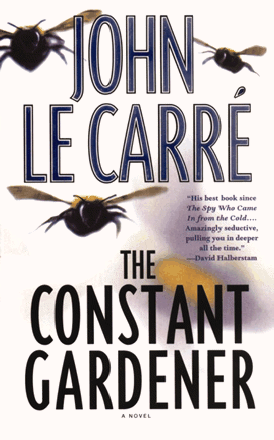 |
© 2004 American Society of Pharmacology and Experimental Therapeutics
Beyond the Bench
The Drug that Came in from the Cold
The Constant Gardener. John le Carré. New York: Simon & Schuster; 2000. 480 pages. $28.00. ISBN: 0743215052
|
John le Carré, best known as the author of post–World War II spy novels, has a masterful knack for portraying global conflict through the lives of ordinary people. With the passing of the cold war, le Carré has turned to the pharmaceutical industry as the alternative setting for his latest novel. A major Swiss pharmaceutical firm, Karel Vita Hudson (KVH), is running clinical trials on Dypraxa, an experimental drug being tested on African tuberculosis patients. KVH has engaged an African health care conglomerate, the House of ThreeBees (Bell, Barker, and Benjamin), to foot one-quarter of the research and development costs in exchange for the exclusive import and distribution rights to Dypraxa in Africa.
At the center of The Constant Gardener is Justin Quayle, a low-profile career diplomat in the British Foreign Service Office in Nairobi, whose wife had been compiling, prior to her untimely death, information concerning the clinical trials of Dypraxa in Africa. Justin had admired Tessa Quayle’s humanitarian spirit and her legal mind, but he knows little about her lawyerly probing into the deaths of patients who had participated in the drug trials. In a journey that encompasses Kenya, Poland, Britain, Italy, Germany, and Canada, Justin carries us along as he searches not for European spies—the typical fare of previous le Carré fiction—but rather for answers to the questions Tessa had been investigating: Was the drug being tested properly for efficacy? Was it safe? Were patients adequately informed? And most importantly, were ThreeBees and KVH conspiring to conceal adverse drug events? Indeed, Tessa’s persistent and vocal prodding had threatened to generate quite unfavorable publicity.
Le Carré has woven an interesting and entertaining tale of intrigue, typical of his spy novels, which include the best sellers, The Spy Who Came in from the Cold, Smiley’s People, and Tinker, Tailor, Soldier, Spy. In this instance, le Carré presents a rarely exposed and at times unsettling perspective on drug development, and he has clearly done his homework. The development of Dypraxa and its pharmacological characteristics are presented in believable detail, beginning with the discovery of Dypraxa, in Poland, by two physicians on leave from the University of Leipzig. During their sabbatical, they demonstrate preliminary clinical efficacy before KVH acquires the rights to develop and market the drug.
|
In a scenario typical of many drugs, Dypraxa performs well in preclinical studies (e.g., no mutagenicity and a long half-life in rats), but subsequent clinical testing reveals isolated incidents of liver failure, internal bleeding, dizziness, and blurred vision secondary to possible optic nerve damage. Nevertheless, Dypraxa meets regulatory requirements for approval in Germany, Poland and Russia, as well as certification for use by the World Health Organization, and KVH is keen to continue the clinical testing and secure registration of the drug in the most lucrative pharmaceutical markets of North America and Europe. Thus, the pursuit of a blockbuster drug forms the backdrop for the plot played out by KVH, ThreeBees, Tessa and, ultimately, Justin.
Le Carré discusses a number of activities and issues that real pharmaceutical teams often confront during clinical development. He portrays the need to obtain informed consent from patients before treatment, the necessity of rewriting protocols due to the appearance of adverse events, and the importance of excluding women of childbearing age under certain treatment conditions. The author also touches on real-life social concerns, such as the possible coercion of needy patients, the solicitation of favorable reports and testimonials by opinion leaders, and the ghostwriting of such testimonials by sponsoring pharmaceuticals firms themselves. The reader is also exposed to some of the realities of biomedical publishing, such as the difficulty of communicating negative data in premier medical journals, the potential for censorship of unpopular data by biased peer reviewers, and the use of confidentiality agreements that can prevent company employees and their associates from communicating research findings.
In positing adverse reactions to the drug, le Carré is careful to explain that Dypraxa is not a bad drug; it is simply being administered improperly. The author points out that insufficient work has been done to characterize its pharmacokinetics, the extent of drug-drug interactions, and the disposition of the drug in patients who are already very sick. In this regard, le Carré highlights a scenario quite common in real drug development. The pressure to enter Phase III trials often compels companies to gloss over—or omit entirely—key Phase II studies whose purpose is to establish optimal dose schedules and define critical inclusion and exclusion criteria. Regulatory agencies, including the FDA, in fact persistently emphasize the need to collect sufficient clinical data on pharmacokinetics, concomitant medications, and comorbidities prior to Phase III. When this advice is not heeded, patients in the targeted therapeutic population may die from drug overdose, or may die from their disease because they are underdosed. In The Constant Gardener, profit is the motive behind KVH’s decision to continue clinical trials, despite serious adverse events.
Le Carré puts a human face on this situation. We see drug development through the eyes of patients and their advocates, including Dr. Lara Emrich, one of the physicians who originally discovered Dypraxa. We become acquainted with patients who willingly submit to experimental treatment, full of hope and trust that Dypraxa is the miracle that will cure them. When one such patient dies, the impact of le Carré’s fictional account is much greater than we might have experienced simply by reading data entries from an actual Case Report Form and a Serious Adverse Event Report. Dr. Emrich is portrayed as a compassionate research scientist whose attempts to proceed cautiously, with scientific rigor, are undermined. To her, financial rewards should be secondary to patient welfare and good clinical practice.
As for KVH, le Carré’s portrait of the drug company is indirect, established rather unsympathetically through the skeptical eyes of patient advocates. However, the practices attributed to KVH do not appear to be out of line with real-life pharmaceutical R&D activities. KVH met or exceeded the regulatory requirements for clinical safety and efficacy necessary to achieve market approval in three countries. It is not uncommon to adjust clinical protocols, as the fictional company appears to do, when adverse events are observed, in order to ensure safety. Similarly, pharma companies often seek the endorsement of key opinion leaders, as does KVH, as a way of encouraging the medical community to use a new drug. Finally, confidentiality agreements are standard practice in the pharmaceutical industry; they are designed to protect the huge financial investment that underlies drug development and to control disclosure of data about drugs that are still under development.
Still, Tessa Quayle and Dr. Emrich view KVH’s efforts with skepticism, convinced that maximizing profits is overriding other important concerns. However, Le Carré is careful to avoid a blanket condemnation, and concedes, "...Not all pharmaceutical companies are careless and greedy." In addition, his plot positions a corrupt distributor, ThreeBees, as the scapegoat for most of the clinical sins.
There are few faults in le Carré’s plot line. Tuberculosis is a major unmet medical challenge in the third world, but it is hard to imagine that any major pharma company would consider a drug like Dypraxa to be a blockbuster. The market for tuberculosis drugs in industrialized nations is not large. Furthermore, the presumed advantage of Dypraxa is the promise of reducing treatment to a few weeks, when in fact most blockbusters depend on chronic treatment to sustain revenues. Also, although many drug companies are increasingly conducting clinical trials in Africa, it is unlikely that they would depend so heavily on African clinics to collect definitive efficacy data. Despite the large patient base for tuberculosis studies, the logistics for monitoring studies in Africa is complicated and too costly for most pharma companies.
The Constant Gardener exposes the reader to a variety of the facets of real-life drug development: basic research and drug discovery, clinical trials, patients and health advocates, and the financial ramifications. In the real world of pharmaceuticals, the cloak-and-dagger dilemmas of the novel’s hero are rare. However, the novel does much to reveal drug development as a high-stakes business that evokes passions from a variety of perspectives, and le Carré’s ability to touch on moral issues is evident in the tale of a naïve, bereaved husband; his protagonist serves as a compelling vehicle to present a very personalized perspective on drug development. It is a perspective that we should keep in mind as we develop new drugs. In this regard, The Constant Gardener is both interesting and thought provoking.
 |
| Rebecca Anderson received her PhD in pharmacology from Georgetown University. Currently, she leads Early Development Operations at Amgen, Inc., in Thousand Oaks, California. |

